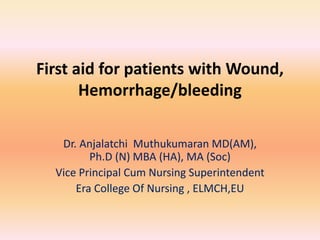
First aid for patients with Wound, Hemorrhage.pptx
- 1. First aid for patients with Wound, Hemorrhage/bleeding Dr. Anjalatchi Muthukumaran MD(AM), Ph.D (N) MBA (HA), MA (Soc) Vice Principal Cum Nursing Superintendent Era College Of Nursing , ELMCH,EU
- 2. Wounds • Any abnormal break in the skin or the body surface is known as a wound.
- 3. Types of Wound • 1. Penetrating wound-wound that breaks through the full thickness of skin. • 2. Non-penetrating wound-wound does not break through the skin. • 3. Miscellaneous wound
- 6. Principles of wound care • 1. To stop the bleeding • 2. To prevent infection • 3. To prevent shock
- 8. Hemorrhage • Haemorrhage or bleeding is a flow of blood from an artery, vein or capillary accompanied an accident in which a wound, a fracture or damage to organs occurs. • Bleeding can occur internally, where blood leaks from blood vessels inside the body, or externally, either through a natural opening such as the mouth, nose, ear, urethra, vagina, or anus, or through a break in the skin.
- 9. Types of hemorrhage or bleeding, • a) arterial Bleeding-blood coming from Arteries ,bright red in colour, spurts. • b) Venous Bleeding-blood coming from veins, dark red in colour, flows steadily. • c) Capillary Bleeding. – blood from small blood vessels, oozes and most common.
- 10. Type of bleeding
- 11. Type of bleeding
- 14. Effects of Extreme Heat Stroke • It occurs when body can no longer controls its temperature anymore and the body’s temperature increases to106 degree or higher within 10 to 15 minutes. • It is caused by very high environment temperature or illness like malaria. • Exposure to heat and humidity for long time • Prolonged confinement in hot atmosphere. • Consumption of alcohol.
- 15. Management • Move the causality to cold place and remove the clothing. • If the casualty is conscious, then place him in half sitting position with head and shoulders supported. • If the casualty is unconscious, then place in recovery position. • Wrap the casualty in a wet sheet and keep it wet. Fan should be on.pour water all over the body. Colds ponging should be started • Replace the body fluids. Give cold water to drink • Apply ice cap with ice pieces over the head and neck. • Cold water enema can be given • If required, shift him to hospital.
- 16. HEAT CRAMPS • Heat cramps, are muscle spasms that result from loss of large amount of salt and water through exercise. This can be caused by inadequate consumption of fluids or electrolytes.
- 17. Treating Heat Cramps • Identify hen you have a heat cramp typically due to exercising or working in hot environments. • Stop the activity ein performed • Heat cramps are not something you “push through” during exercise. They are your body’s way of telling you that it needs a break. • Rest in a cool environment • Find a cooler spot in the shade or indoors and give yourself time to rest and cool down
- 18. Drink plenty of fluids • The cramp is a response to dehydration and loss of electrolytes, so you should also drink lots of fluids while you rest. Dissolve a quarter or half teaspoon of regular table salt into one quart of water • Gently stretch the muscles that are cramping.
- 19. Hand out
- 20. Thank you
